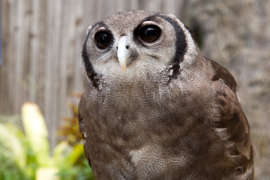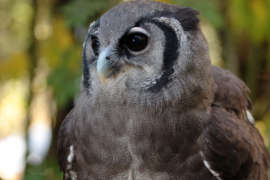Milky Eagle Owl
Milky Eagle Owl
This is one of the larger owls in the world, and they prey on virtually any small to medium-sized animal. They generally hunt at night, and long-term pairs produce usually two eggs per year, often with only one surviving to fledge.
Bubo lacteus
Carnivore
Eastern Africa, Southern Africa [VIEW MAP]
Forests, Scrublands, Woodlands
The milky eagle owls are easy to find and can be seen nearly anytime except on our coldest days, when they may be indoors. During the nesting season, the female often will be incubating her eggs or chicks in the nest box. Otherwise, these owls usually sit conspicuously in their habitat. Contrary to popular belief, they do not sleep all day, and can often be seen awake and active during Zoo hours.
Photos and Videos
Owls occur on all continents except Antarctica and are known for their generally, but not exclusively, nocturnal behaviors. They have specialized structures on the head and feathers to aid their senses and nearly soundless flight. Their silence, persistent gaze, and nocturnal habits make them figure prominently in tales, myths and stories across cultures worldwide. Often, they are symbols of death or wisdom. The milky eagle owl earns its name from the distinctive bare upper eyelids that are easily visible during a blink or a nap. During the breeding season, the eyelids of the males become pinkish or purple, strongly suggesting a role in visual communication associated with reproduction. Females are generally larger than males.
Like all owls, milky eagle owls have numerous adaptations for hunting. The legs are powerfully strong, with long, sharp talons on each toe. This power, combined with the major force of impact that owls can achieve, means that most prey of any size are killed instantly upon impact. The edges of each feather bear soft, hair-like textures that eliminate the distinctive flapping sound that we hear when most birds take off into flight or change direction suddenly.
Their eyes are massive and offer exceedingly keen vision, even under very low light conditions. The distinctive behavior or head-bobbing from side-to-side maximizes their depth perception, which is crucial in order to make the perfect prey strike. The so-called feathery ears atop the heads of many owls, including the milky eagle owl, are not ears at all. Those are physical adornments associated with communication and signals between individuals. The actual ears are not visible and are located along the outside edge of each eye underneath the feathers. The ears are of different size and orientations, which allows for very strong abilities to sense direction and distance of sounds. This amazing adaptation allows owls to pinpoint the location of prey they cannot see, such as rodents running under packed snow or grasses, as well as prey in zero-light conditions.
Pairs often stay together for multiple years and produce two eggs annually. Usually only one of the chicks survives to fledging, but then may stay with the pair for up to two years, assisting to raise subsequent chicks. The owls at Zoo Atlanta are very productive and produce chicks nearly every year; their offspring are shared with accredited zoos across the country.
The milky eagle owls are easy to find and can be seen nearly anytime except on our coldest days, when they may be indoors. During the nesting season, the female often will be incubating her eggs or chicks in the nest box. Otherwise, these owls usually sit conspicuously in their habitat. Contrary to popular belief, they do not sleep all day, and can often be seen awake and active during Zoo hours.
Much of the African continent, except for the northern deserts and the densest forests
Savannas and open woodlands
In the wild, virtually any animal of small to moderate size can fall prey to these owls. Zoo diet includes mice, rats, chicks, quail, and a commercially prepared bird-of-prey supplement.




